
Water is necessary for life and survival. You are 60 to 70 percent water. It’s necessary for all bodily functions. You can only last three to four days without it. Having a storage of clean drinking water and knowing how to safely treat more is vital to “be ready” for survival.
Store a MINIMUM of one gallon per person per day
Store a MINIMUM of one gallon per person per day. A normally active person needs about three quarters of a gallon of fluid daily, from water and other beverages. However, individual needs vary depending on age, health, physical condition, activity, diet and climate. Children, elderly, sick, nursing mothers, or those who are physically exerting themselves will need more. A medical emergency might require additional water. If you live in a warm weather climate more water may be necessary. In very hot temperatures, water needs can double. You will also need additional water for food preparation and hygiene.
Store a BARE MINIMUM of two weeks supply for your family
It is recommended to store a supply of one month or more. If you are unable to store this quantity, store as much as you can. Then store more water as space, budget, and ability allow.
Resources
- Ready.gov | Preparing Your Own Containers of Water
- Ready.gov | Water
- Ready.gov | Storing Water in Plastic Soda Bottles
- CDC | Creating and Storing an Emergency Water Supply
- CDC | Making Water Safe in an Emergency
- BeReady.Utah.gov | Water
- ChurchofJesusChrist.org | Emergency Preparedness
- ChurchofJesusChrist.org | Personal and Family Emergency Preparedness | Planning Guide
If supplies run low, never ration drinking water unless ordered to do so by authorities. Drink the amount you need today and try to find more for tomorrow. Minimize the amount of water your body needs by reducing activity and staying cool. Do not drink carbonated or caffeinated beverages instead of drinking water. Caffeinated drinks and alcohol dehydrate the body which increases the need for drinking water.
Drink water that you know is not contaminated first. If necessary, suspicious water, such as cloudy water from regular faucets or water from streams or ponds, can be used after it has been treated. If water treatment is not possible, put off drinking suspicious water as long as possible but do not become dehydrated.
There are a few things that negatively affect your water storage. Whenever you are storing something for the long term, the ideal conditions are cool, dark, and dry at temperatures between 40 and 60 degrees. Contamination also affects your storage.
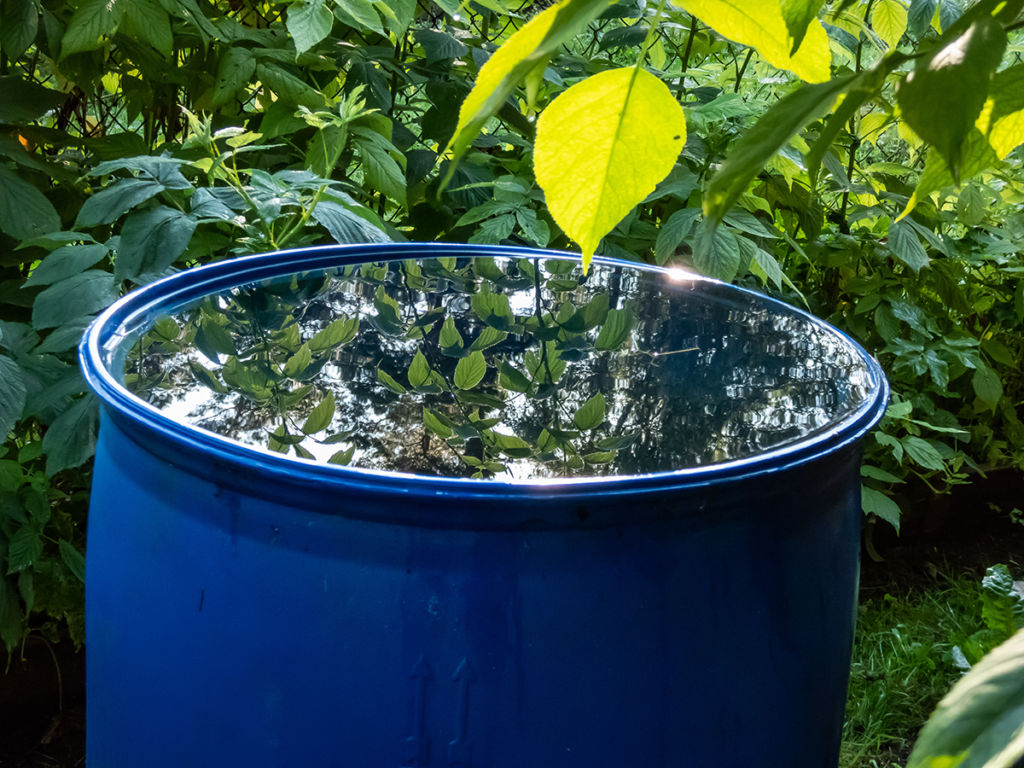
- Light from the sun, and even artificial light, breaks down the integrity of water containers, causing them to become brittle or leak. Standard 55 gallon blue water barrels in direct sunlight can start to fall apart within five years. Light also causes algae to grow. Limit sunlight, or even any light, as much as possible in water storage areas. Sunlight, via photosynthesis, causes algae to grow in stored water. It doesn’t pose a health risk, but it’s not fun to chew your drinking water.
- Temperature extremes promote bacteria and algae growth. Just like sunlight, warm storage temperatures can promote bacteria and algae growth in water. Limit extremes in temperatures in storage areas as much as possible.
- Moisture buildup on and around the outside of your storage container can promote mold growth which will produce toxins that can pass through container walls into your water. Keep the outside of containers dry and off the ground.
WATER STORAGE CONTAINERS
There’s a lot of different things that people use to store water. Some are better than others.
Commercially bottled water CDC recommends that you purchase commercially bottled water to prepare the safest and most reliable emergency supply of water. Bottled water is convenient, ready to go right from the package, and is a good size for carrying. Keep the bottled water in its original container, and do not open it until you need to use it. Bottled water has a recommended two to three year shelf life. Not the water, but the bottle itself is designed to start breaking down after a number of years. Make sure you rotate and use your stores.
Bottled water is convenient to use, but is also a less effective use of space compared to larger containers. If you are limited in your available storage space, don’t put all of your water storage in water bottles. Additionally, even though the cost per bottle is not extravagant, it is more expensive than municipal water from your tap at pennies per gallon. Also know that a lot of commercially bottled water IS just bottled tap water.
Pre-used containers can be an inexpensive and easily accessible means of storing water if other options are difficult to come by. Larger food grade containers can sometimes be obtained from restaurants or other food preparation locations inexpensively. Take care as to which containers you choose because residual food deposits in the container may be difficult to remove. If left behind, they can promote bacterial growth in your stored water. Also, remember that your water will probably taste like whatever was in the container previously. Reconsider using containers with strong odors. You will never be able to remove them from the container. A great option for water storage are two and three liter plastic soda pop bottles. They are durable and air tight, perfect for long-term water storage. Just make sure they are completely cleaned and rinsed before filling. Thoroughly clean the bottles with dishwashing soap and water. Be sure to completely rinse out all residual soap to prevent a soapy taste in your water. Sanitize the bottles by adding a solution of 1 teaspoon of unscented liquid household chlorine bleach to a quart (1/4 gallon) of water. Swish the sanitizing solution in the bottle so that it touches all surfaces. Let it sit for at least 30 minutes before emptying it and rinsing with fresh, clean water
DO NOT use containers which held chemicals or other dangerous substances. You can NEVER make it clean enough to be safe for drinking water. Some like to use these containers to store water for cleaning and sanitation purposes. That’s OK, just label them as such. If you are limited on storage space, just store drinkable water.
DO NOT use plastic jugs that had milk or fruit juice in them. The reason is that milk proteins and fruit sugars cannot be adequately removed from these containers and provide an environment for bacterial growth when water is stored in them. Also these containers quickly break down and become brittle.
Food grade plastic containers made from a High Density Polyethylene (HDPE) are the standard and recommended way to store water for the long term. Look for the “2” in the recycling triangle. They are affordable and easy to find.. Get dark, solid colors to block light from reaching your water.
Glass containers are not as permeable as plastic and leave no taste or odor in the store water, BUT because glass is easily broken and the broken shards are dangerous, glass is not recommended for water storage. If you choose to fill empty canning jars with drinkable water,
store them on bottom shelves.
Metal containers are heavier than plastic and can leave metallic taste in stored water. There is also a possibility of rust unless you use a stainless steel container. Stainless steel water bottles are popular, but are not intended for long-term water storage. Metal containers are not recommended for water storage.
FILLING CONSIDERATIONS
There are some things you want to consider and plan for before you fill your water storage containers.
Use a drinking water hose, also known as an RV or boat hose, instead of your garden hose. At worst, even brand new garden hoses can add contaminants to your water. At best, garden hoses give your water a rubbery taste.
Fill your container to the top to get out as much air as possible and to keep gaskets and seals moist to maintain a tight seal.
Treat non Chlorinated water If your tap water is treated with chlorine, you do not need to add anything else to the water to keep it clean. If the water you are using comes from a well or water source that is not treated with chlorine, add two drops of unscented liquid household chlorine bleach to each gallon of water. Make the water safe for use before storing it. Depending on the emergency, you may not have time or ability to treat the water.
Tightly close the container using the original cap. Be careful not to contaminate the cap by touching the inside of it with your fingers. Write the date on the outside of the container so that you know when you filled it.
STORAGE CONSIDERATIONS
There are some things you want to think about when considering WHERE and HOW you are going to store your emergency supply of water. In all of emergency preparedness, there is ideal and then there is what we can really do. Budget, time, storage space, and many other factors determine how close we can get to ideal. Don’t get discouraged and don’t give up. Do what you can with what you have. Adapt to your circumstances, needs, and abilities and set a goal to upgrade as you can. Something is always better than nothing.
Keep it cool, dark, and dry. An ideal storage location would be in constant temperatures between 40 and 60 degrees without sunlight in a room without windows or the windows blacked out, and low humidity. This prevents contaminating organism growth and container breaking or leaking.
Store water in a variety of container sizes. Large containers are the most efficient use of your space but are difficult to move. Store water in smaller containers as well that are able to be carried to kitchens or restrooms where water is needed. When empty, siphon from the larger containers.
Do not store directly on the concrete. Put on a pallet, 2x4s or something to allow air to circulate under and around the container. Water condensation or spills will promote microbial growth which creates toxic gasses. Elevating the container off the ground allows the moisture to evaporate. Concrete also emits toxic gasses. Elevation allows the gasses to dissipate rather than be trapped underneath to eventually be absorbed.
Think about emptying and refilling before filling. Full water barrels and tanks weigh hundreds if not thousands of pounds.an empty 55 gallon barrel weighs about 25 pounds when empty and about 480 pounds when full. Once it’s full, it’s not moving. Find a place that makes it easy to empty and fill your containers.
Check yearly. Check for odd smells, discoloration, contamination, and leaks. Replace if necessary. Be careful not to introduce contamination when checking for contamination.
Rotation. It is recommended by the CDC to replace the water every six months if not using commercially bottled water.
Multiple storage locations. As the old saying goes, don’t keep all your eggs in one basket. Store water in more than one location because if one area is lost or damaged in an emergency, you have more elsewhere.
Ideal Water Storage: Locations: Indoors in a basement or food storage room.
OK Water Storage Locations: Garage, storage shed, and under sinks. Rotate every one to two years. Beware of proximity to possible chemical contaminants and odors that could seep through the plastic wall of the storage container.
Last Resort Water Storage Location: Outside. Store on the north side of the house or another outbuilding and cover with a heavy tarp to help prevent sunlight from reaching the containers and to protect from other contaminants deposited by wind, rain, and animals. Rotate at least every 6 months in spring and fall. Don’t fill to the top, leave a little room for expansion from possible freezing and heating. Replace containers every 5 to 10 years. Remember to NOT store it directly on the ground.
HIDDEN WATER SOURCES IN YOUR HOME
Did you know you have other sources of water already in your home, ready to use, that you may not have thought about?
House water pipes. Depending on your house, you could have around 20 to 40 gallons of clean drinking water in the pipes of your home right now. If an emergency happens that could affect the cleanliness of that water, like a flood or an earthquake, if you suspect the water lines may be contaminated, quickly shut-off the incoming water valve that connects your home to the municipal water supply. Don’t turn back on until told the water is safe by authorities. Locate that valve now and practice turning it off and on. This will not damage anything. If there is a problem or the valve will not close, contact a reliable plumber and get it fixed as soon as possible. Teach all responsible people in your household how, where, and when to turn off the water. To dispense the water, shut-off the main valve, then open the highest valve or faucet in the house to let air into the system. Then you can dispense from the lowest faucet in the home.
Water heater. There could be about 40 additional gallons of water in your hot water heater. To use this water, shut off incoming water at the main valve to the home. Then, following the manufacturer’s instructions in your water heater’s user manual, shut off the gas or power supply to the heater. The water will most likely be very hot, so allow it to cool in the tank before dispensing from the bottom water spigot. This is another reason, besides preventing an explosive gas leak, to have your water heater safely strapped to the wall to keep it from falling over in the event of an earthquake, so you don’t lose these precious gallons of water.
Canned fruits and vegetables come packed in liquid. Though you may not want to drink it unless you are desperate, you can use this water in food preparation to spare your clean water for drinking. Be creative. Fruit juices can be used for breads and cookies while vegetable juices would work for preparing soups, pasta dishes, and rehydrating dehydrated or freeze-dried meals.
Melted ice cubes made with water that was not contaminated
Water from your home’s toilet tank (not from the bowl), if it is clear and has not been chemically treated with toilet cleaners such as those that change the color of the water Tank water that has been chemically treated should be used for sanitation and cleaning purposes not drinking.
Pools, hot tubs, and waterbeds are NOT recommended for use as drinking water even with high quality water treatments because the chemicals used in them are too difficult to be removed with even the best consumer water filters.
SOURCES OF WATER OUTSIDE THE HOME
If you need to find water outside your home, you can use these sources:
- Rainwater
- Streams, rivers, and other moving bodies of water
- Ponds and lakes
- Natural springs
Whatever your source of water, don’t assume the water is clean just because it’s flowing and looks clean. Treat all outside water sources with caution. If there is any question as to the safety of your water, from inside OR outside sources, treat it before using it for drinking, food washing or preparation, washing dishes, brushing teeth or making ice. In addition to having a bad odor and taste, contaminated water can contain microorganisms (germs) that cause diseases such as dysentery, cholera, typhoid and hepatitis. You can’t afford to get sick, especially during an emergency situation. Even if it looks clean – TREAT IT!
Rain
Catch and store rainwater, but be sure to treat it before drinking. Find out if your roofing material is safe for collecting water. After a disaster, there may be debris in the air that is captured in the rain drops. Always treat it.
Lakes, Rivers, and Streams
Find local places now for alternate, outside sources of water. Always choose the cleanest source. Remember to “drink upstream from the herd”, but there may still be another herd further upstream. Always treat it.
Man-Made Water Areas
Like fountains, golf course water traps, fish ponds, drainage ditches,
etc. contain massive amounts of chemicals, fertilizers, and pesticides. DO NOT try to use these! They are too contaminated for commercially available treatments to effectively make the water safe for drinking.
Avoid water with floating material, an odor, or dark color. Use saltwater only if you distill it first. You should not drink flood water.
WATER TREATMENT
There are many ways to treat water, though none are perfect. Often the best solution is a combination of methods. Boiling or chlorination will kill most microorganisms but will not remove other contaminants such as heavy metals, salts, and most other chemicals. Water treatment is a three part process. All are necessary, especially if you are unsure as to the quality of your water source and what is contaminating it.
- Pre-filtration
- Filtration
- Purification
Pre-Filtration
Pre-filtration is the first process. This gets the large particles, the “chunks” out and lengthens the useful life of your filter. Your filter can easily filter out these large, visible particles, but your filter will clog much sooner. Save money and save your filter by pre-filtering. Allow suspended particles to settle to the bottom of the container or collect them at the top to be skimmed off. Then pour the water through layers of paper towel, clean cloth, or coffee filter. Anything that is
clean to pour the water through. Have a container to catch the pre-filtered water. Remember, this is only pre-filtered water. It is not yet ready for drinking.
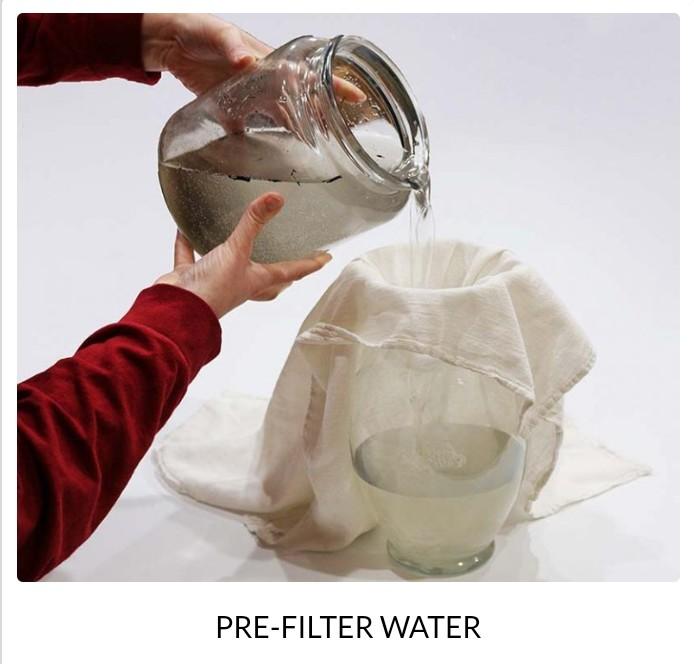
The next two processes can be done in either order depending on your situation.
Filtration
Filtration is a physical barrier that traps particles and contaminants as water passes through. The lower the micron level of the filter, more smaller particles will be filtered out. There are many different options, levels of quality, sizes, types, and styles of water filters. Depending on the filter, they can remove chemicals, sediments, protozoa, bacteria, and heavy metals. Most filters do not remove viruses, but we don’t have an issue with viruses in our water in North America. All filters have a suggested water capacity for replacement. How well you pre-filter your water will determine if your filter’s life span will fall short of or exceed its suggested replacement time. When water flow greatly diminishes or pumping gets extremely difficult, it is time to dispose of and replace or clean your filter. Refer to manufacturer’s directions for replacement or cleaning. Consider your needs, abilities, number of people you will be supplying water for, potential sources of water, and potential contaminants when deciding which water filters to purchase.
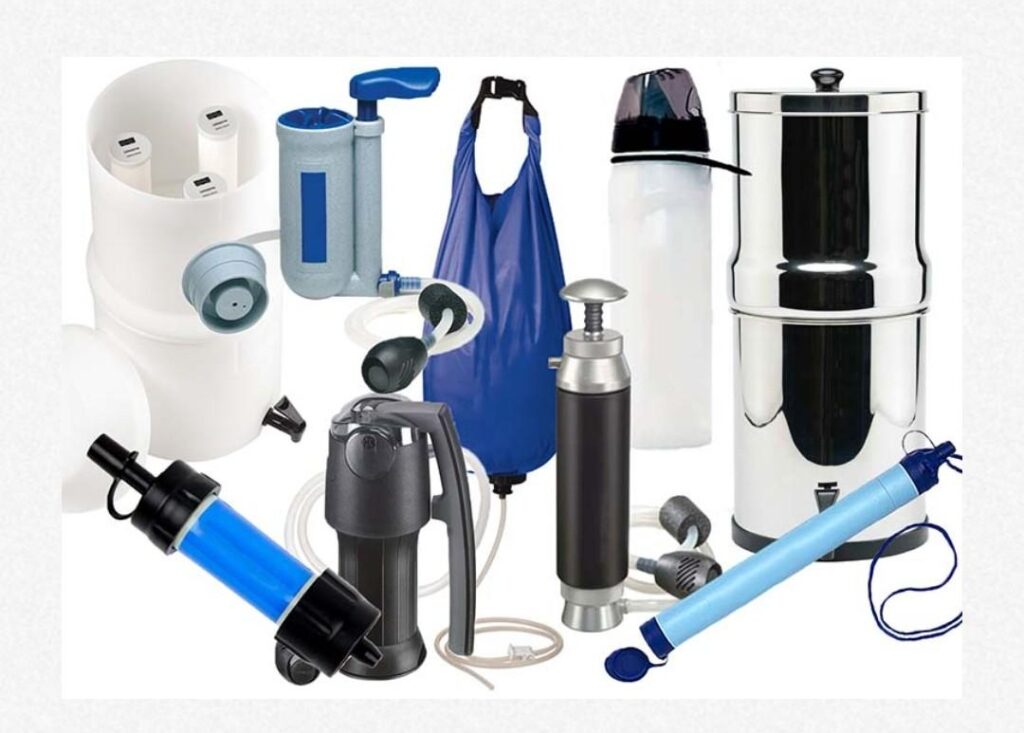
Gravity-Fed Filters
Gravity fed filters use gravity to pull the water through the filter. They tend to be larger and sit on a tabletop or hang. They are slower than other filters but do not require constant attention. They work well for at home, work, or camping with a group.
Pump Filters
Pump filters are usually what people think of with water filters. The hand pumping action pushes water through the filter. It is faster than gravity fed and can be used with a small group of people. This is the style you would want in a group emergency evacuation kit.
Straw Filters
Straw filters are meant to be used by only one person. One end of the filter goes in the water while the user sucks on the other end like a straw and draws the water through the filter. Some of these can also be used in the line of a hydration bladder for filtration on the go. To be most effective, straw filters need to have their source water purified first.
Water Bottle Filters
Water bottle filters are similar to straw filters in that the user draws the water through the filter while sucking on the mouthpiece. The source water is contained in the bottle around the filter. To be most effective, these too need to have their source water purified first.
Ceramic and Fiberglass Filters
Ceramic and fiberglass filters use different media to block the particles as the water passes through them. Microscopic pores in the materials allow the water to pass while catching the contaminants. Ceramic Filters have the added benefit of being able to be rinsed off to prolong their usefulness. Fiberglass and other types of filters need to be replaced periodically according to manufacturers’ instructions. Gravity fed, pump, straw, and water bottle filters usually use
some combination of these materials to filter water.
Reverse Osmosis
Reverse osmosis is a process used in your home’s pressurized in-line system. It will work if there is pressure in the water line. Most do not require electrical power unless you need an electrical pump.
Activated Carbon
Activated carbon absorbs chemicals and dissolved minerals as the water passes through. It is often used to make tap water taste better and to remove bad odor. Activated carbon filters by themselves are NOT adequate for removing harmful microorganisms. Some gravity fed or pump filters use activated carbon as a part of their filtration process to aid in removing chemicals and dissolved minerals while improving taste.
Avoid “homemade” filters unless there is no other option. There is a lot of misinformation about how to make a filter yourself. If you choose, you can learn the principles so you know how if you need to, but use it as a last resort. Spend the money now to get quality filters for disaster supply kits and for your other emergency needs.
Purification
Purification involves either a heat, UV light, or chemical process that kills the organisms living in the questionable water. Most purification processes do not remove anything from the water.
Heat purification processes require fuel, which is possibly a scarce commodity in an emergency.
- A rolling boil (recommended) for 1 full minute will kill all organisms in the water. Let the water cool before using it. Higher elevations will require a longer boiling time. A lid helps water boil faster and prevents loss from evaporation. Remember, boiling does not remove anything from the water, it just kills it. Sediments, chemicals, heavy metals and salts remain if not already filtered out. Boiled water will taste better if you put oxygen back into it by pouring the water back and forth between two clean containers or adding a pinch of salt for each quart or liter of boiling water. This will also improve the taste of stored water.
- Distilling is more involved, but does a better job than boiling alone because it removes the water from the contaminants. While boiling will kill most microorganisms in water, distillation will remove heavy metals, salts and most other chemicals. Distillation involves boiling water and then collecting only the vapor that condenses. The condensed vapor will not include salt or most other impurities. Easy distiller: Fill a pot halfway with water. Tie a cup to the handle on the pot’s concave lid so that the cup will hang right-side-up when the lid is upside-down. Make sure the cup is not dangling in the water. Boil the water for 20 minutes. The water that drips from the lid into the cup is distilled.
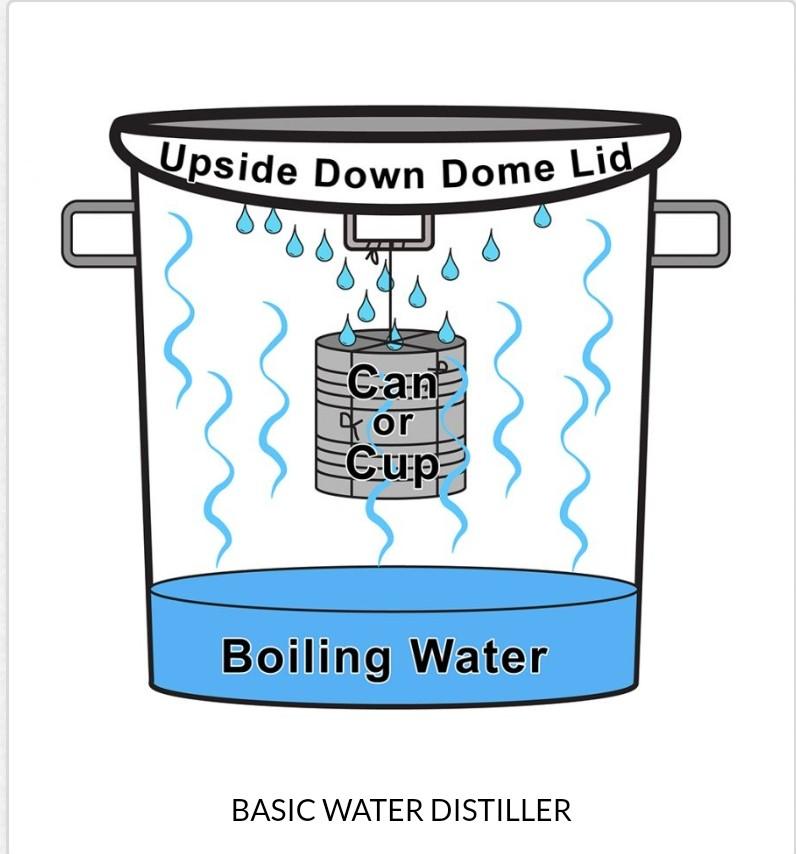
- Ultra violet (UV) light purification or sunlight can also be used to purify water. UV sunlight and a clear, plastic, two liter soda pop bottle can be used to purify water. It takes time and a clear, sunny day, but it works. Know that it is not very effective with cloudy water. Pre-filter the water first. The bottle should be clear plastic and no more than two a liter size, but you can use smaller. Lay the bottle perpendicular to the sun for the greatest sunlight penetration. It is more effective if the bottle is laid on a reflective surface like foil or a mirror. Wait six hours on a sunny day or two full days if it’s partly cloudy. There are also commercial products available that use UV light, but they require batteries.
Chemical purification does not remove anything from the water; it only kills what’s in it. Be sure to closely follow manufacturer’s directions in how to use their products.
- Iodine has been used for chemically treating water for many years. It has a 4 to 5 year shelf life in an unopened bottle, 1 year in an opened bottle, and is susceptible to heat, protozoa, so if you are unaware of what’s in the water, be sure to filter it as well. Water that has been treated with iodine is NOT recommended for pregnant women, people with thyroid problems or have an allergy to iodine. It is also not recommended for continuous use. Do not use iodine longer than a few weeks straight. It is intended for short-term emergency use only.
- Sodium hypochlorite (liquid bleach) Use only regular household liquid bleach that contains 5.25 to 8.25 percent sodium hypochlorite. Do not use scented bleaches, color safe bleaches, or bleaches with added cleaners. Because the potency of bleach diminishes with time, (it has a six month to one year shelf life) use bleach from a newly opened or unopened bottle. To use, Add 1/8 teaspoon of bleach per gallon of water, stir and let stand for 30 minutes. The water should have a slight bleach odor. If it doesn’t, then repeat the dosage and let it stand another 15 minutes. If it still does not smell of bleach, discard it and find another source of water.
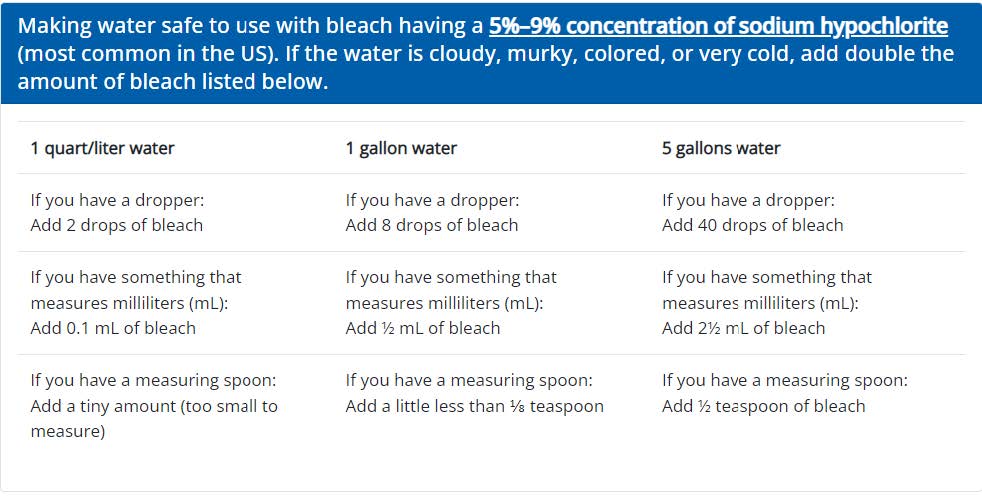
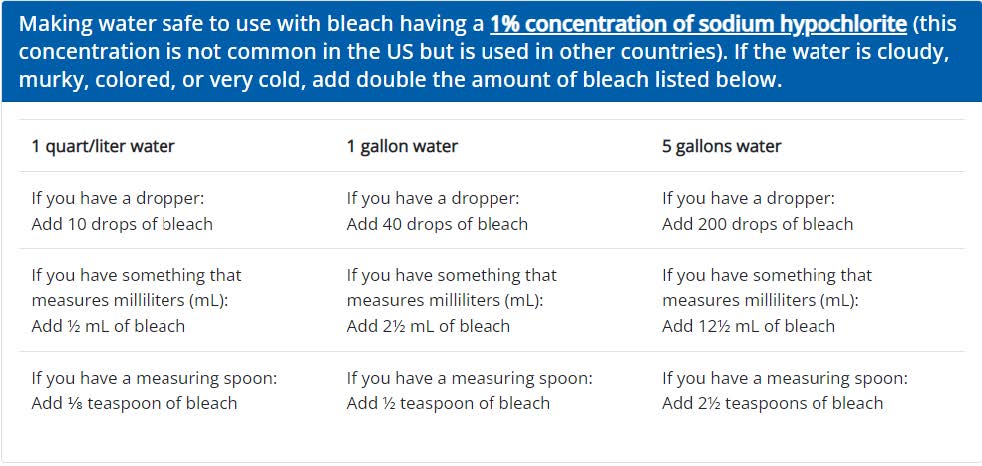
- Chlorine dioxide has a 4 to 5 year shelf life and comes in liquid or tablets. The liquid form treats water faster (about 30 minutes), but it’s a little more difficult to mix the two reacting chemicals together and let them sit for 15 minutes before pouring them in the water than to just drop in a tablet which requires four hours of processing. If this is your preferred method of water purification, use the liquid for at home treatments and the tablets for disaster supply kits and backpacking. Chlorine dioxide is iodine and chlorine free. It works by releasing nascent oxygen, which is a strong oxidant and a powerful germicidal agent into the water. It has greater pathogen killing power than iodine or chlorine, but is much safer for continual use as long as it is used in correct dosages in the drinking water. Unlike iodine, chlorine dioxide does not discolor water, nor does it give water an unpleasant taste. It’s often used to improve the taste of water.
FOOD GRADE PLASTIC CONTAINERS
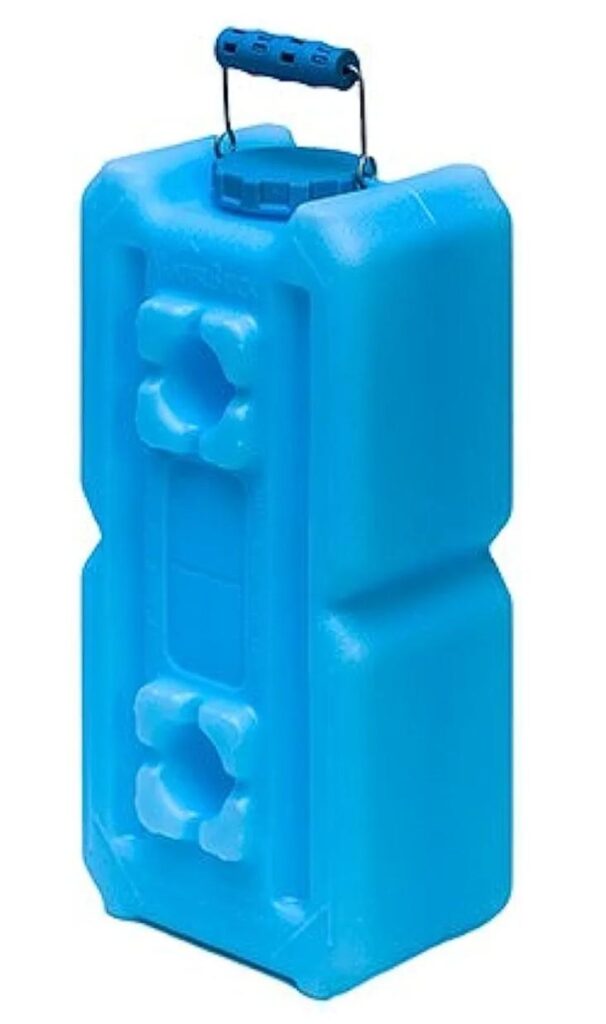
WaterBrick
Dimensions: Each unit is 9 inches wide, 18 inches long, and 6 inches high. Small enough to carry, fit in a refrigerator, and under beds.
Thickness: 1/8” Thick
Capacity: – Each unit will hold 3.5 gallons / 13 liters of water or 27 pounds of dry food.
Stackable: Waterbricks can be stacked on top of each other – like Legos up to 4-feet high, both perpendicularly and horizontally.
Durable: Made of industrial food grade High Density Polyethylene
Resin; 5 year warranty but Ultra Violet additive will extend the life up to
15 years
Safe Dry Storage: BPA free and Food Grade approved; store water, food, or anything you want to keep dry
Multifunctional: Use as a bulk storage system, block of ice, sand bag
- Amazon – $115.89 – 6 units; $179.99 – 10 units
- Sam’s club – $74.98 – 4 units
- Waterbrick.com – $37.00 – 2 units
- Home Depot – $91.90 – 4 units
- Walmart – $124.49 – 6 units; $159.87 – 8 units
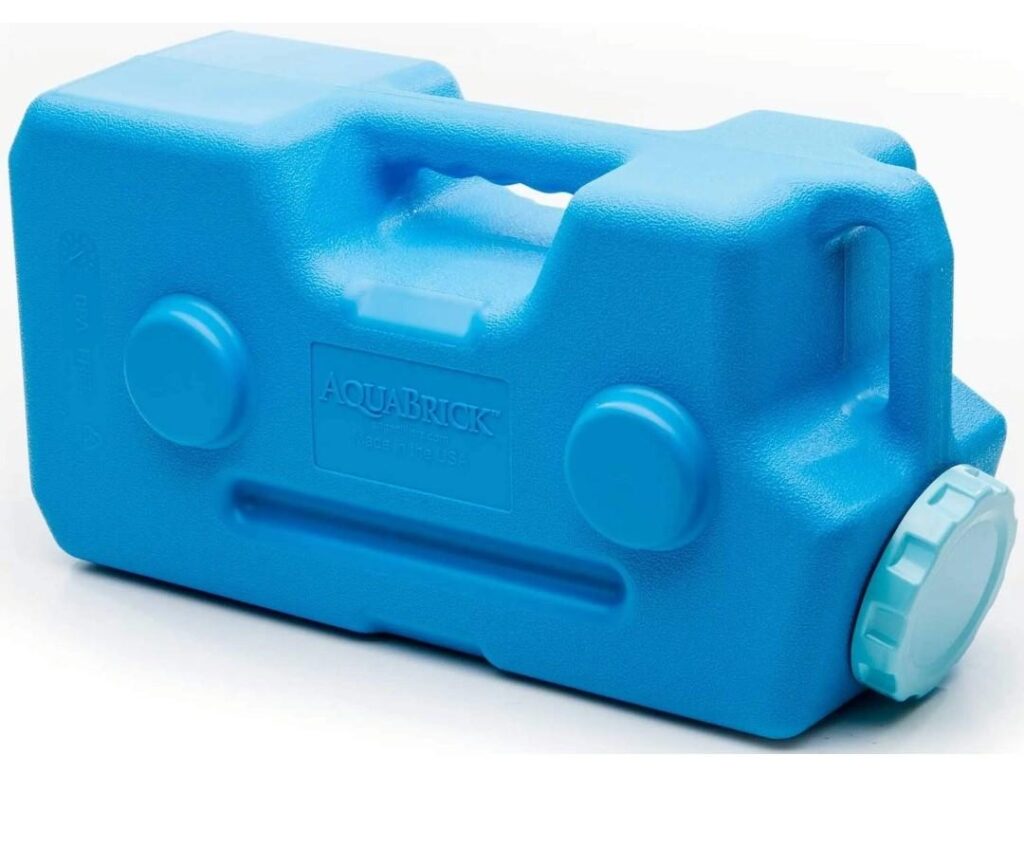
AquaBrick
Dimensions: Each unit is 9 inches wide, 18 inches long, and 6 inches high. Small enough to carry, fit in a refrigerator, and under beds.
Thickness: 1/16” Thick
Capacity: Each unit will hold 3. gallons / 11.35 liters of water or 20 pounds of dry food.
Stackable: Waterbricks can be stacked on top of each other like Legos – Recommended stacking height is 5 bricks high.
Durable: Made of industrial food grade High Density Polyethylene Resin.
Safe Dry Storage: BPA free and Food Grade approved; store water, food, or anything you want dry
Multifunctional: Use as a bulk storage system, also has a Water Purification system that can be purchased separately
- Walmart $87.50 – 4, $185.95 – 6
- Amazon $185.85 – 6
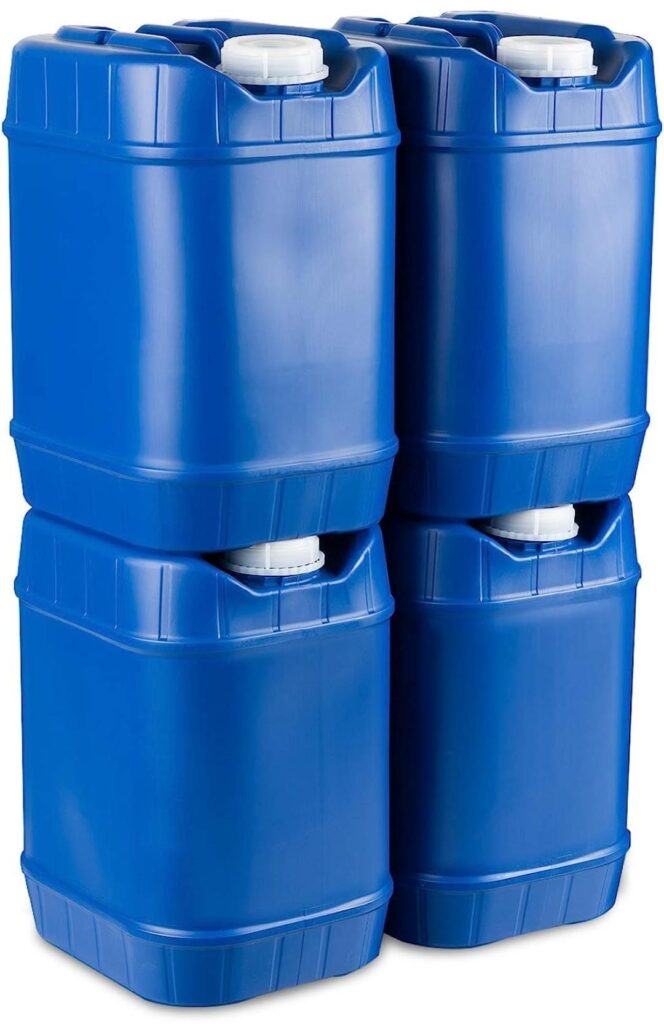
Stackables
Dimensions: Each unit is 11 inches wide, 10 inches long, and 14 inches high.
Capacity: Each unit will hold 5 gallons / 18.92 liters
Stackable: Stackables can be stacked on top of each other. Recommended maximum stacking height is 3 unit high.
Durable: Made of industrial food grade High Density Polyethylene Resin with flat bottoms and tops that nestle
together and molded handle.
Safe Dry Storage: BPA free and Food Grade approved;
Multifunctional – Can be used for storing other liquids or food
necessities.
- Amazon $67.99 – 2 units $114.99 – 4 units $159.99 – 6 units
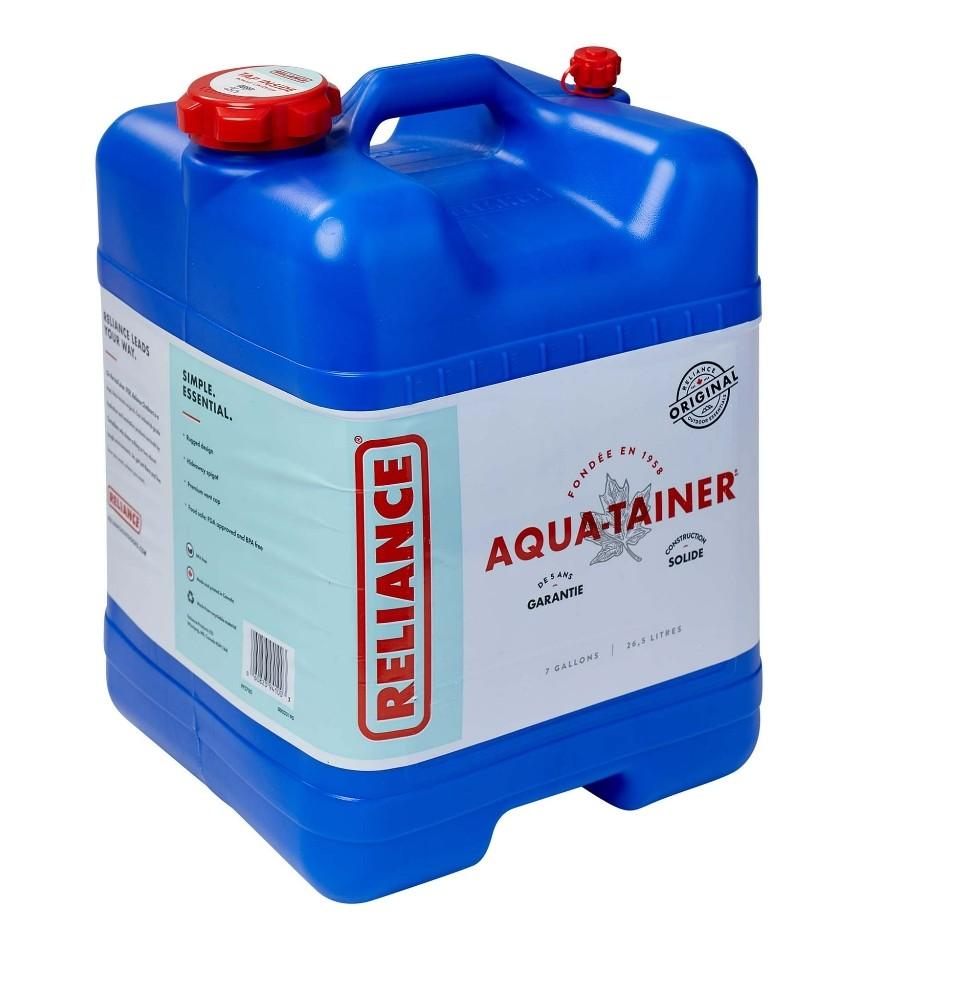
Aqua-Tainer
Dimensions: Each unit is 11 inches wide, 11.25 inches long, and 15.25 inches high.
Capacity: Each unit will hold 7 gallons / 26 liters
Stackable: when empty for compact storage
Durable: AquaTainer is made tough and rugged. The Contoured Built-in handles makes it easy to carry. The spout is designed for convenient dispensing when needed and reverses for safe, damage-free storage and transport. Five-year warranty against
manufacturer’s defects.
Safe Dry Storage: BPA free and Food Grade approved;
Multifunctional: Useful for several different applications
Cost
- Walmart $19.88
- Amazon $33.55
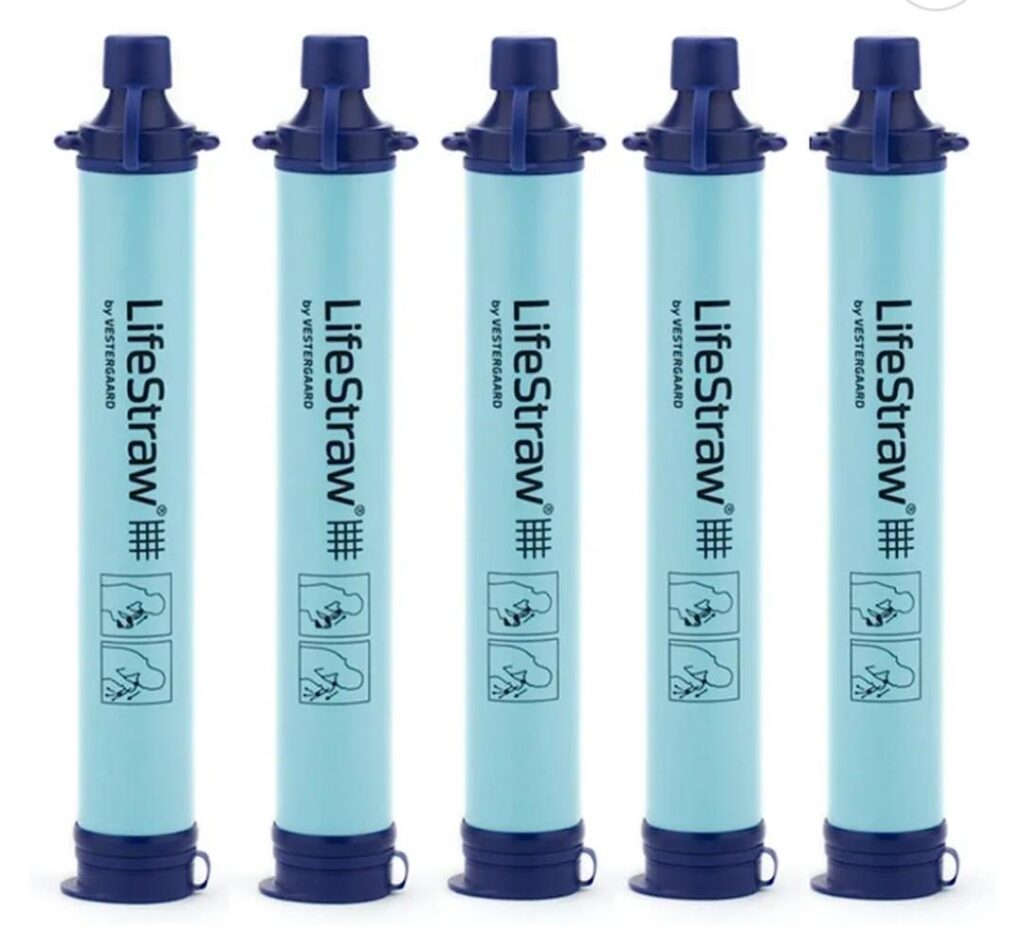
LifeStraw (Straw Filter)
- This official LifeStraw personal water filter will provide 792 gallons (3,000 liters) of safe drinking water without using chemicals, iodine.
- Removes 99.9999% of bacteria including Escherichia coli (e-coli), campylobacter, vibrio cholera, pseudomonas aeruginosa, shigella, salmonella
- Removes 99.9% of protozoa including giardia lamblia (beaver fever), cryptosporidium parvum, entamoeba histolytica
- No shelf life, can be stored indefinitely even after use
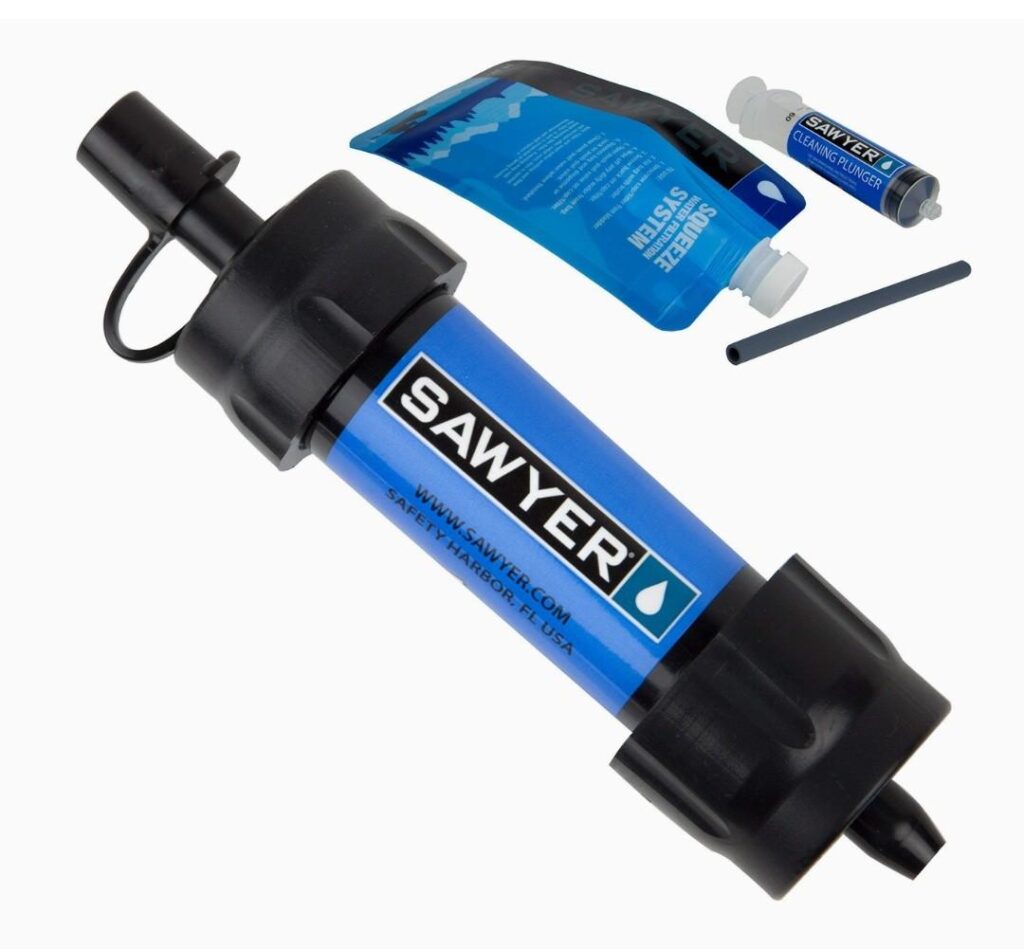
Sawyer Mini (Straw Filter)
- High-performance 0.1 Micron absolute inline filter fits in the palm of your hand and weighs just 2 ounces;
- Attaches to included drinking pouch, standard disposable water bottles, hydration packs, or use the straw to drink directly from your water source
- Removes 99.99999% of all bacteria (salmonella, cholera, and E. coli); removes 99.9999% of all protozoa (such as giardia and cryptosporidium); also removes 100% of microplastics
- Filter rated up to 100,000 gallons; Includes one Sawyer MINI filter, 16-ounce reusable squeeze pouch, 7-inch drinking straw, and cleaning plunger.
Cost
- Walmart $21.97
- Amazon $21.97
- Bass Pro Shop $29.99
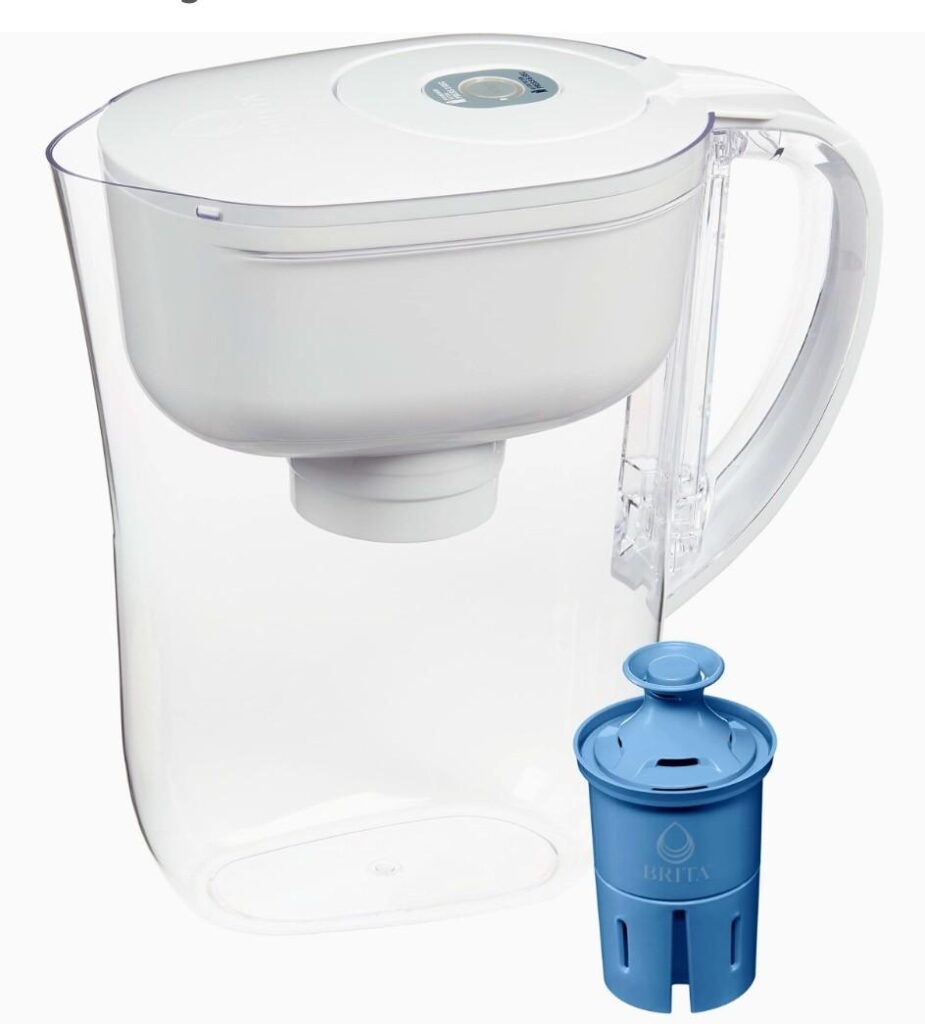
Brita Pitcher (Gravity Filter)
- Brita Denali water pitcher is made without BPA, easy to fill, and can hold 6 cups of water, enough to fill 2 24-ounce reusable water bottles;
- Space efficient Denali pitcher is fridge friendly, features an easy-fill lid and SmartLight filter indicator;
- Height 9.37″; Width 4.45″; Length 9.8″; Weight 0.996 pounds
- Reduce 99% lead, Chlorine (taste and odor), Cadmium, Mercury, Benzene, Asbestos, microplastics, and more*, while an electronic indicator makes filter reminders effortless
- Brita Elite filters are compatible with all Brita pitchers and dispensers except Stream; replace the Brita Elite water filter 2x a year (about every 6 months)
Cost
- Brita.com $35.99
- Walmart $27.99
Filter replacement – Elite
- Walmart $14.89
- Amazon $19.99
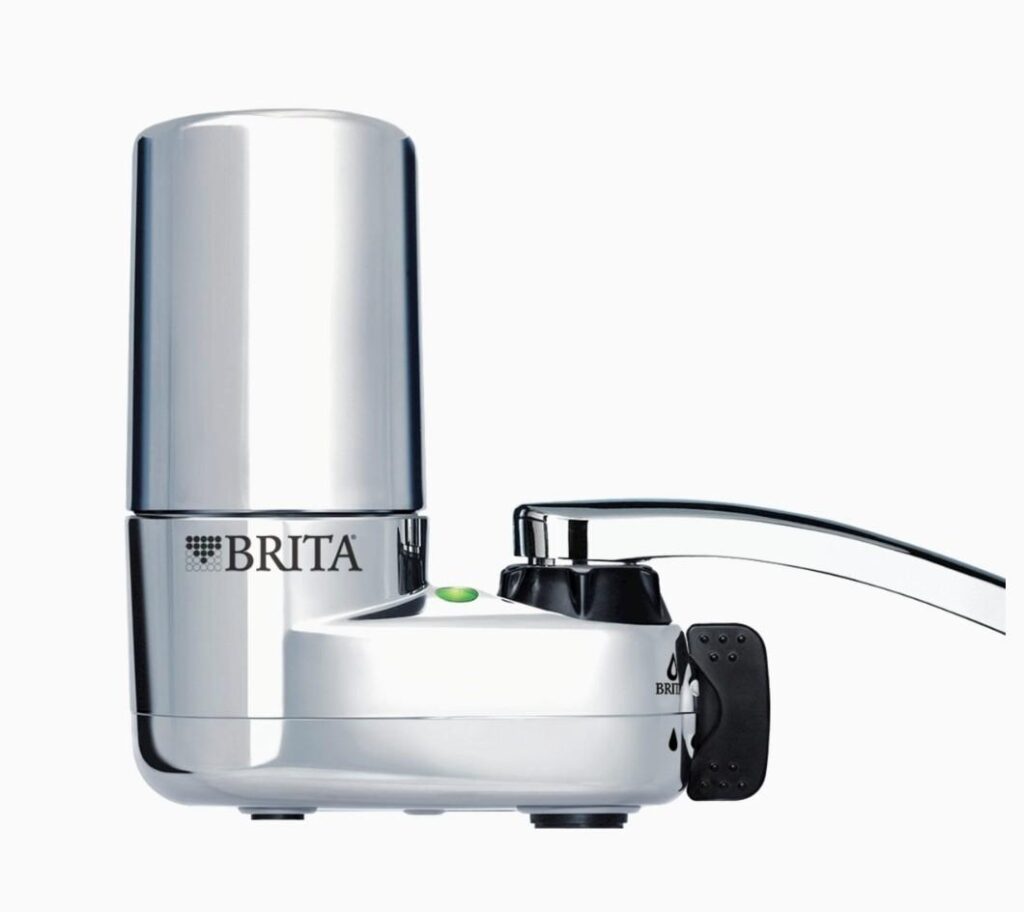
Brita Faucet
- Basic Brita faucet water filter attaches to your standard faucet making tap water cleaner and great-tasting; filtration system is easy to install; no tools required
- The space efficient design attaches directly to your faucet giving you the choice of filtered or unfiltered water; Available in white and chrome color with a filter indicator for easy replacement reminders;
- Height 5.28″; Width 4.8″; Depth 2.26″; Weight .84 pounds
- Reduce 99% of lead, chlorine (taste and odor), asbestos, particulates, Benzene, and more; a helpful status indicator lets you know when to replace the filter with an easy 1-click filter replacement
- Replace your faucet mount water filter every 100 gallons or approximately every 4 months to keep water tasting great; this tap water filter fits standard faucets only, does not fit pull-out or spray style faucets
Cost
- Walmart $30.89
- Amazon $43.5
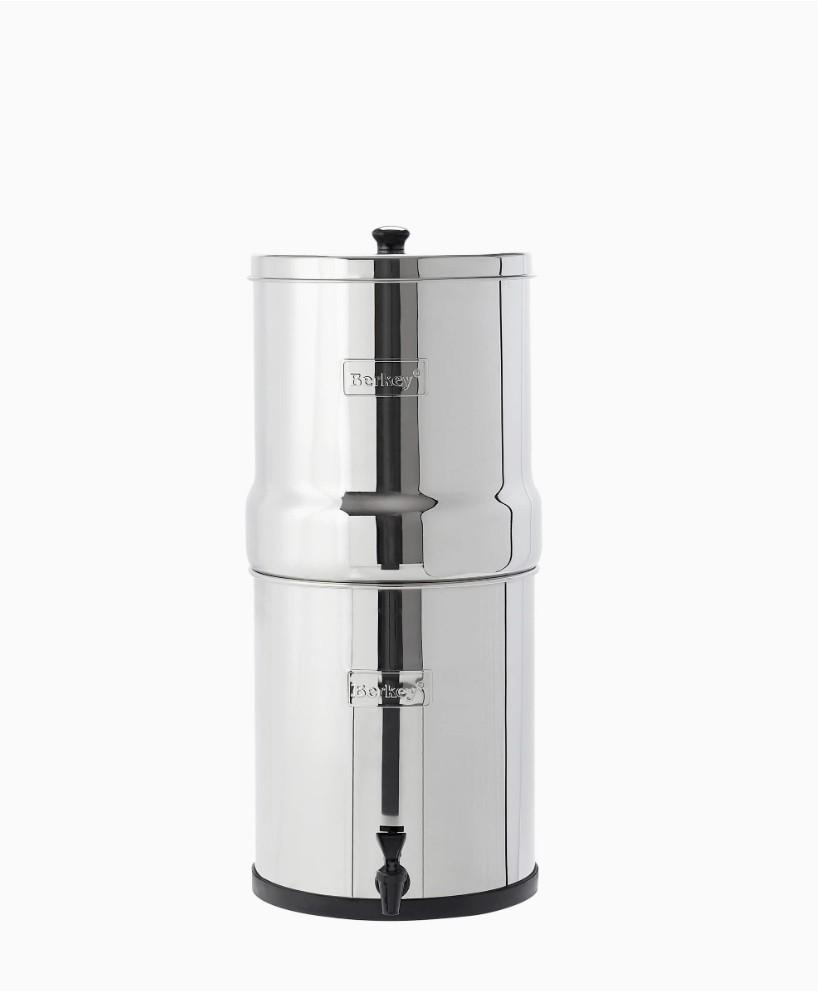
The Big Berkey (Gravity Filter)
- The portable Big Berkey System has a 2.25 Gallon capacity and can effortlessly filter water for about 1-4 people each day. Add additional 2 Black Berkey Elements, sold in sets of 2, to increase the flow rate (sold separately)
- The system is just 19.25” tall and 8.5” in diameter and can be used on a countertop in your kitchen or office to transform bad-tasting tap water into delicious drinking water.
- Black Berkey Elements remove or dramatically reduce over 200+ typical contaminants that could be present in your tap water, lakes, rivers, ponds, streams and other freshwater sources—no electricity, tools, or plumbing are required.
- Each pair of Black Berkey Elements lasts for up to 6,000 gallons before replacement is recommended. Elements may require replacement sooner based upon the quality of influent water. Each additional pair of Black Berkey adds an additional 6,000 gallons of contaminant reduction.
Unit Cost
- Amazon $384.00
- Walmart $367.00
Filter Cost
- Amazon $49.99 2 pk
- Walmart $166.00 2 pk